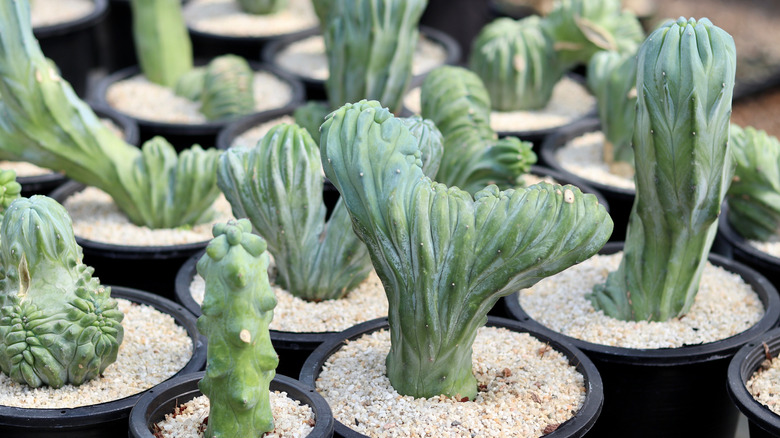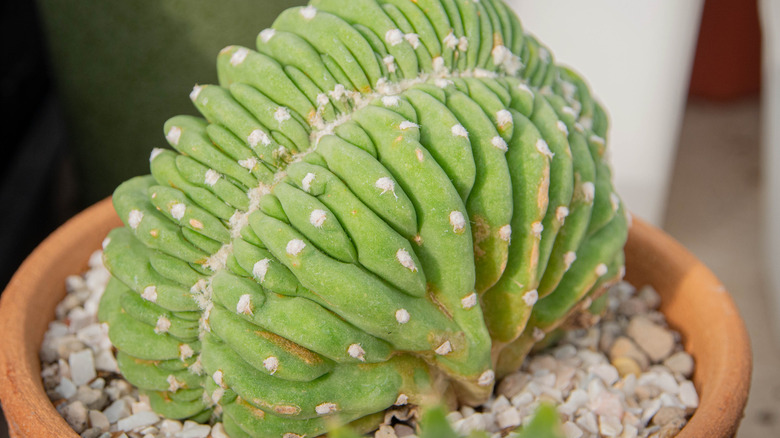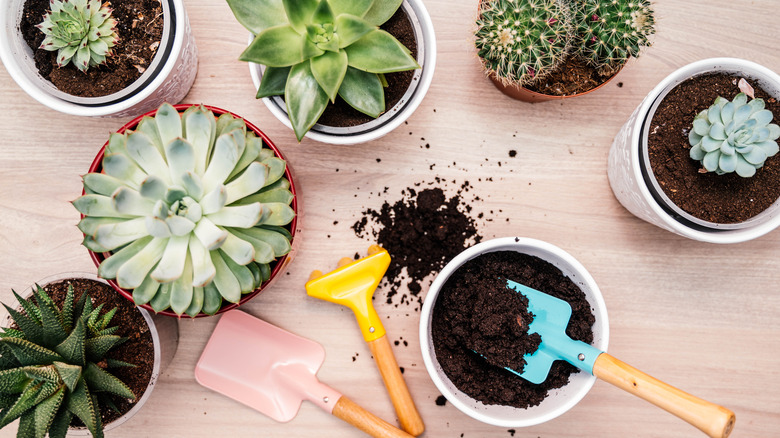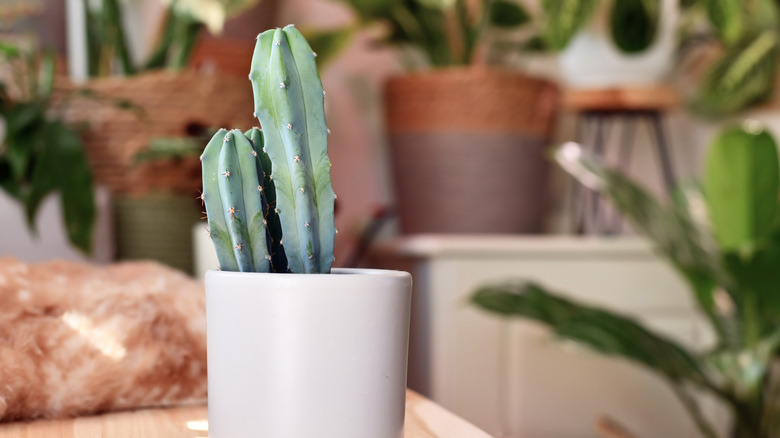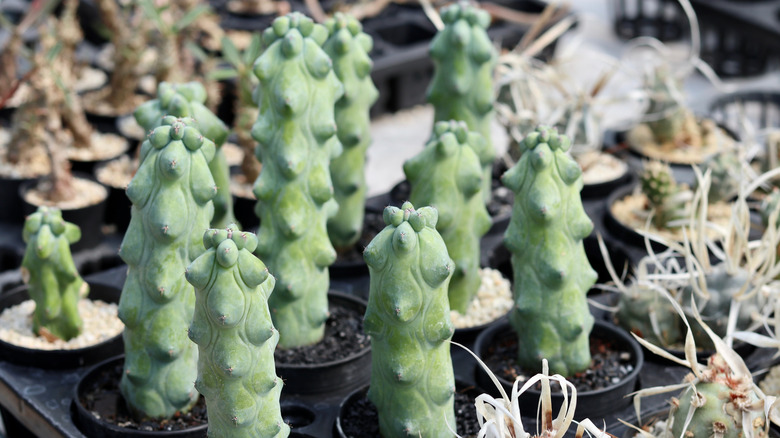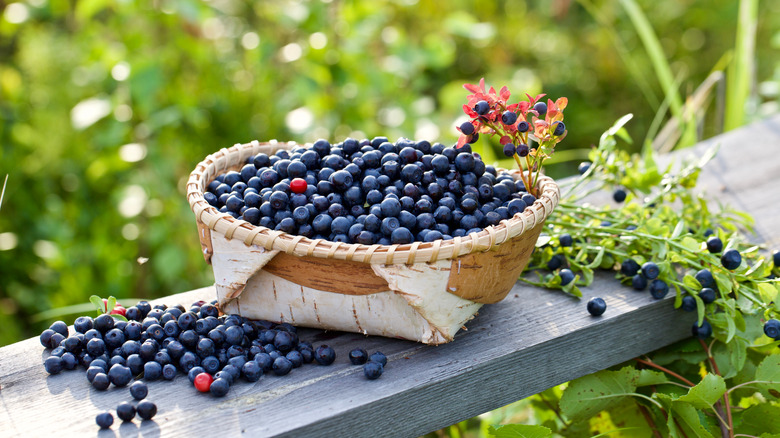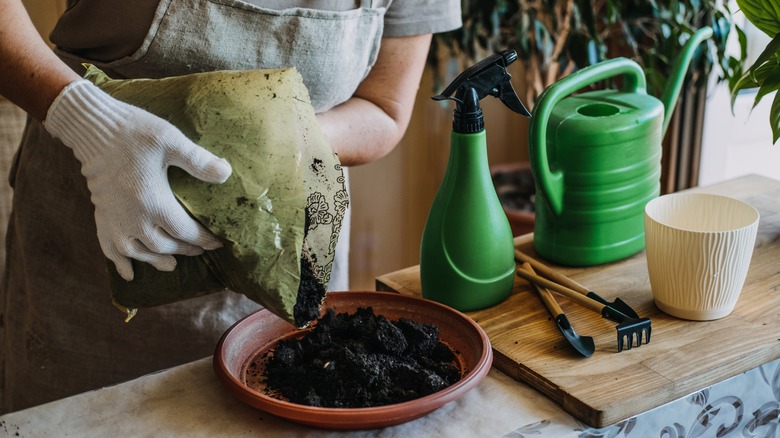How To Care For A Blue Smoke Cactus
New and seasoned plant lovers can't seem to get enough of succulents. Their fame stems from the fact that they are easy to take care of. They are able to thrive in various environments, from the coast to the tropics, and can be kept inside or outside the home. They are also very accessible — you can always get one to fit your budget.
The succulent plant has many major families, including the Agavaceae (century plant and Spanish dagger family), Aloaceae (aloe), and the largest ones: the Cactaceae (cactus) and Aizoaceae (ice plant). According to the Arizona-Sonora Desert Museum, cacti are so popular among gardeners and plant owners that they are only surpassed by roses and orchids! It may be because they are one of the most adaptable plants and have evolved in all sorts of ways to survive.
Native to Central and Northern Mexico, the blue smoke cactus is scientifically known as Myrtillocactus Geometrizan and its other names include the blue crest and crested blue candle. It is the most popular species of the genus Myrtillocactus (via Plant Care Today). It grows fast and can get up to 13 to 16 feet in height. Its stems usually grow around 2- to 4-inches in size. Blue smoke can have elements of blue, green, and/or grey.
How to use a blue smoke cactus in garden
No one actually knows for sure how blue cactus plants came along, but we do know that the color isn't common in nature, per Gardening Know How. Whether inside or outside, blue smoke can be used to diversify any landscape because its unique color stands out when placed in the midst of various plants. At least 2 feet tall, blue smoke cacti will start to bloom and produce small, yellow flowers. They also produce purple fruits known as bilberries. These various elements and colors can be used to your advantage when gardening. Depending on the climate, season, size, and age of your plant, it will need to be either indoors or outdoors.
If you want an indoor plant, the Fukurokuryuzinboku (breast cactus) looks great on a shelf or table when it is small. Coupled with others of varying heights and shapes, it adds a lot of character to a space! Bigger blue smokes can be placed in a location furthest from the entrance of a room.
For a garden or outdoor space, the plants can be spaced out from other ones and not too close to where people pass by. This way, they can be better appreciated in their full glory for their size, shape, and color as they spread. They've been compared to candelabras for a reason!
How to grow a blue smoke cactus
As with other succulents, blue smoke is easy to propagate. A leaf or a branch from somewhere else can become your own plant in a matter of weeks. Using a sterile, sharp knife or pair of scissors, remove a stem and allow it to form a callus for several days. Put it into well-draining soil and then water whenever the soil has dried out completely. Be conscious of the fact that cuttings only root in weather that is warm or hot.
Want to use seeds? This step-by-step guide by House & Garden Care breaks it down, recommending warm months as the time to plant. Start by cleaning a ripe fruit and let it dry completely. After, you can plant the seeds. Proper light and the appropriate amount of water will ensure that this plant grows the way it's supposed to. It hardly needs pruning, either.
How to care for a blue smoke cactus
This plant grows well in an outdoor garden and loves being in the sun fully. It does well in partial sun but will need to be kept indoors in really cold zones because it can only tolerate temperatures down to 25 degrees Fahrenheit (-4 Celsius), according to Plant Care Today. Younger plants don't need the full sun and should be kept in a light shade until they mature and can be moved.
To water, try this technique outlined in this watering guide by Succulents and Sunshine. First, ensure the plants are in soil that will let water drain well without it pooling and in a pot with good drainage. This is because succulents will rot fast if they are in wet soil for too long. Then, soak the dirt thoroughly and allow it to fully dry before watering it again. Plant Care Today says a specialized cactus fertilizer once a month in the spring and summer is great for growth.
Blue smoke cactus varieties
From the Japanese variation to beautiful color combinations, the variations of the blue smoke cactus are popular and quite distinct in their appearances and qualities.
- The Fukurokuryuzinboku is a Montrose cultivar from Japan. It is a rare cactus with swollen tubercles that look like human breasts, which is why it is also referred to as the 'Breast Cactus', 'Booby Cactus', or 'Titty Cactus'. Its stems grow up to 3 to 10 centimeters thick with 3 to 5 spines that are about 5 to 12 millimeters long (via LLIFLE).
- The cristata variegata is another variation that has a yellow at the top of the ribs that contrasts well with the glaucous blue at the bottom. With stems up to 7 to 10 centimeters in diameter, the 5 to 8 ribs are approximately 2.5 centimeters in depth with areoles that are spaced approximately 2.5 centimeters apart (via LLIFLE).
- The Myrtillocactus geometrizans crested, or crestata, is a rare and popular variation where the ribs are clumped together. Its blue color becomes brighter with the proper sunlight, according to Tula.
Is the blue smoke cactus toxic?
Blue smoke is mildly toxic to animals and people. In its raw form, it can cause gastrointestinal ailments in pets and contains mescaline, which is one of the powerful hallucinogens on earth (via Garden Beast). Their thorns can also injure the throat and mouth so the raw plant needs to be kept well out of the reach of children and pets. It should also be placed in an area where it will not be in the way to due to its shape and size.
However, the fruits of blue smoke cacti are edible! The bilberries are commonly sold as garambullos in Mexico due to their flavor and health benefits. The plant can be found in various regions like Baja California, the State of Mexico, Durango, Guanajuato, Michoacán, and many others. Bilberries make jelly, jam, drinks, liqueurs, and even ice cream! They are known as a great source of vitamin C, fiber, and antioxidants.
How to repot a blue smoke cactus
Because of how fast it grows and its size, expect to repot the blue smoke every one to two years. If the plant is over-watered to the point of damage, repotting may also help. The best time to do so is early spring as that's when they come out from their dormant period, says Tula. Otherwise, the summer months are good for repotting as well, whenever they overgrow their pot. According to Plantophiles, it is better to put blue smoke cactus in a smaller pot than a bigger one because too much soil can hinder the roots and stems from proper growth. They also insist on using new soil and fertilizer.
Always check the roots for deterioration and remove any weak ones. Don't water after repotting. Instead, give blue smoke cactus about a week to adjust because when it's dry, the transition to the new pot will be easier (via House & Garden Care). Ideal pots will be made out of clay, ceramic, and terracotta.
